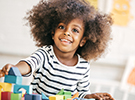Number Yard
In this lesson, children will create their own number yard books by drawing the number of objects that correspond with the numbers on the pages of the book.
Lesson for:
Toddlers/Preschoolers
(See Step 5: Adapt lesson for toddlers or preschoolers.)
Content Area:
Algebra
Numbers and Operations
Learning Goals:
This lesson will help toddlers and preschoolers meet the following educational standards:
- Understand numbers, ways of representing numbers, relationships among numbers and number systems
- Understand patterns, relations and functions
Learning Targets:
After this lesson, toddlers and preschoolers should be more proficient at:
- Developing understanding of the relative position and magnitude of whole numbers and of ordinal and cardinal numbers and their connection
- Sorting, classifying and ordering objects by size, number and other properties
- Connecting number words and numerals to the quantities that they represent, using various physical models and representations
- Counting with understanding and recognizing “how many” in sets of objects

Number Yard
Lesson plan for toddlers/preschoolers
Step 1: Gather materials.
- The book, Grandpa Gazillion’s Number Yard by Laurie Keller
- A pre-made book for each child with the numbers 1-10 on each page (Write the number in words and numerals.)
- Markers or crayons
Note: Small parts pose a choking hazard and are not appropriate for children age five or under. Be sure to choose lesson materials that meet safety requirements.
Step 2: Introduce activity.
- Explain that you are going to read a story about your crazy grandpa, who has a number yard instead of a junk yard. At this number yard, he uses numbers to help people. Ask the children if they can think of ways that numbers might help people.
- Explain that they are also going to create their own number junkyard books. Invite the children to follow along as you read the story.
Step 3: Engage children in lesson activities.
- Begin reading the story. After you read a page with a number on it, pause and have the children draw an object that corresponds with the number in their number books. For example, after you read the following statement from the book: “You are hungry and stuck on a tall mountain peak? A lollipop NINE can last you all week!” Ask the children to draw nine of something that they would want if they were stuck on a tall mountain peak. Continue this throughout the book until their number books are finished.
- After the number books are completed, the children might want to dictate and have you write down what they want to say about each page.
Additional Extensions
- You can also create a number book with large numbers 1-20 on each page. Instead of representing the numbers with pictorial objects, the children can create other objects from the already existing numbers and incorporate the numbers into their drawings. For example, the number 8 can become glasses on the face of person.
Step 4: Vocabulary.
- Count: To identify the amount of something by number (e.g.,”Count the number of objects needed for the number nine.”)
- Represent: A quantity of something whose characteristics represent the entire batch (e.g.,”Draw the correct number of objects that represent the number nine.”)
Step 5: Adapt lesson for toddlers or preschoolers.
Adapt Lesson for Toddlers
Toddlers may:
- not know number names or understand the count sequence
Child care providers may:
- Demonstrate what a group of nine looks like using manipulatives, count the manipulatives with the children and then support the children as they draw nine objects on the 9 page
- Read the book slowly (read a page or two a day and reinforce each number that is being worked on throughout the day)
Adapt Lesson for Preschoolers
Preschoolers may:
- Be able to successfully represent each number with pictorial representation
Child care providers may:
- Create a number book with large numbers 1-20 on each page.
- Instead of representing the number with pictorial objects, the children can create other objects from the already existing numbers and incorporate the numbers into their drawings (e.g., the number 8 can become glasses on the face of person)
Suggested Books
- Grandpa Gazillion’s Number Yard by Laurie Keller (New York: Henry Holt and Company, 2005)
Music and Movement
Outdoor Connections
Get some exercise! Call out a number and an exercise and have the children do the corresponding exercises to that number while counting along: 10 jumping jacks, run in place for 15 seconds—counting as you complete the exercises or the time.
Comment on this lesson